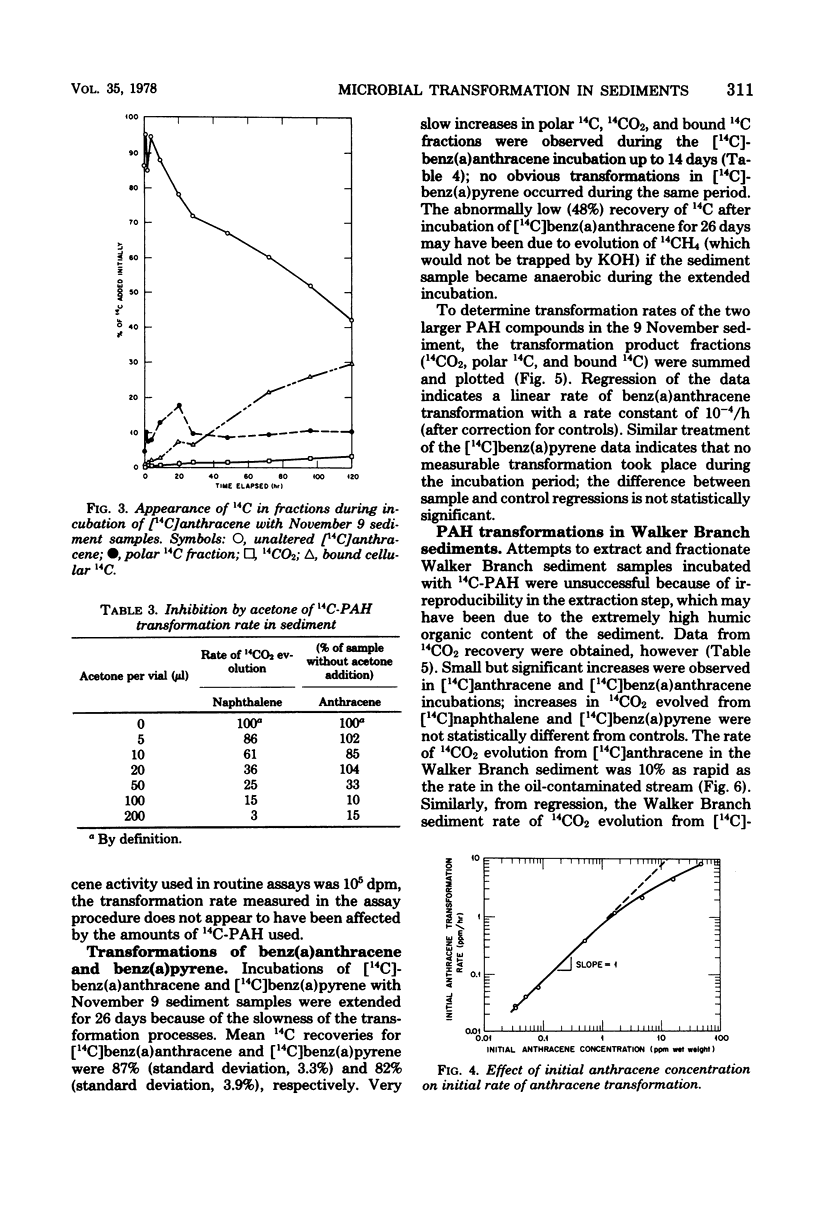Abstract
To determine rates of microbial transformation of polycyclic aromatic hydrocarbons (PAH) in freshwater sediments, 14C-labeled PAH were incubated with samples from both pristine and petroleum-contaminated streams. Evolved 14CO2 was trapped in KOH, unaltered PAH and polar metabolic intermediate fractions were quantitated after sediment extraction and column chromatography, and bound cellular 14C was measured in sediment residues. Large fractions of 14C were incorporated into microbial cellular material; therefore, measurement of rates of 14CO2 evolution alone would seriously underestimate transformation rates of [14C]naphthalene and [14C]anthracene. PAH compound turnover times in petroleum-contaminated sediment increased from 7.1 h for naphthalene to 400 h for anthracene, 10,000 h for benz(a)anthracene, and more than 30,000 h for benz(a)pyrene. Turnover times in uncontaminated stream sediment were 10 to 400 times greater than in contaminated samples, while absolute rates of PAH transformation (micrograms of PAH per gram of sediment per hour) were 3,000 to 125,000 times greater in contaminated sediment. The data indicate that four- and five-ring PAH compounds, several of which are carcinogenic, may persist even in sediments that have received chronic PAH inputs and that support microbial populations capable of transforming two- and three-ring PAH compounds.
Full text
PDF










Selected References
These references are in PubMed. This may not be the complete list of references from this article.
- Abbott B. J., Gledhill W. E. The extracellular accumulation of metabolic products by hydrocarbon-degrading microorganisms. Adv Appl Microbiol. 1971;14:249–388. doi: 10.1016/s0065-2164(08)70546-x. [DOI] [PubMed] [Google Scholar]
- Andelman J. B., Suess M. J. Polynuclear aromatic hydrocarbons in the water environment. Bull World Health Organ. 1970;43(3):479–508. [PMC free article] [PubMed] [Google Scholar]
- Brown E. R., Hazdra J. J., Keith L., Greenspan I., Kwapinski J. B., Beamer P. Frequency of fish tumors found in a polluted watershed as compared to nonpolluted Canadian waters. Cancer Res. 1973 Feb;33(2):189–198. [PubMed] [Google Scholar]
- Calder J. A., Lader J. H. Effect of dissolved aromatic hydrocarbons on the growth of marine bacteria in batch culture. Appl Environ Microbiol. 1976 Jul;32(1):95–101. doi: 10.1128/aem.32.1.95-101.1976. [DOI] [PMC free article] [PubMed] [Google Scholar]
- EVANS W. C., FERNLEY H. N., GRIFFITHS E. OXIDATIVE METABOLISM OF PHENANTHRENE AND ANTHRACENE BY SOIL PSEUDOMONADS. THE RING-FISSION MECHANISM. Biochem J. 1965 Jun;95:819–831. doi: 10.1042/bj0950819. [DOI] [PMC free article] [PubMed] [Google Scholar]
- Gibson D. T., Mahadevan V., Jerina D. M., Yogi H., Yeh H. J. Oxidation of the carcinogens benzo [a] pyrene and benzo [a] anthracene to dihydrodiols by a bacterium. Science. 1975 Jul 25;189(4199):295–297. doi: 10.1126/science.1145203. [DOI] [PubMed] [Google Scholar]
- Herbes S. E., Schwall L. R., Williams G. A. Rate of microbial transformation of polycyclic aromatic hydrocarbons: a chromatographic quantification procedure. Appl Environ Microbiol. 1977 Aug;34(2):244–246. doi: 10.1128/aem.34.2.244-246.1977. [DOI] [PMC free article] [PubMed] [Google Scholar]
- Jerina D. M., Daly J. W., Jeffrey A. M., Gibson D. T. Cis-1,2-dihydroxy-1,2-dihydronaphthalene: a bacterial metabolite from naphthalene. Arch Biochem Biophys. 1971 Jan;142(1):394–396. doi: 10.1016/0003-9861(71)90298-0. [DOI] [PubMed] [Google Scholar]
- Malaney G. W., Lutin P. A., Cibulka J. J., Hickerson L. H. Resistance of carcinogenic organic compounds to oxidation by activated sludge. J Water Pollut Control Fed. 1967 Dec;39(12):2020–2029. [PubMed] [Google Scholar]
- Malaveille C., Bartsch H., Grover P. L., Sims P. Mutagenicity of non-K-region diols and diol-epoxides of benz(a)anthracene and benzo(a)pyrene in S. typhimurium TA 100. Biochem Biophys Res Commun. 1975 Sep 16;66(2):693–700. doi: 10.1016/0006-291x(75)90565-3. [DOI] [PubMed] [Google Scholar]
- Seki H. Method for estimating the decomposition of hexadecane in the marine environment. Appl Environ Microbiol. 1976 Mar;31(3):439–441. doi: 10.1128/aem.31.3.439-441.1976. [DOI] [PMC free article] [PubMed] [Google Scholar]
- Shamsuzzaman K. M., Barnsley E. A. The regulation of naphthalene metabolism in pseudomonads. Biochem Biophys Res Commun. 1974 Sep 23;60(2):582–589. doi: 10.1016/0006-291x(74)90280-0. [DOI] [PubMed] [Google Scholar]
- Sisler F. D., Zobell C. E. Microbial Utilization of Carcinogenic Hydrocarbons. Science. 1947 Nov 28;106(2761):521–522. doi: 10.1126/science.106.2761.521. [DOI] [PubMed] [Google Scholar]
- WALKER N., WILTSHIRE G. H. The breakdown of naphthalene by a soil bacterium. J Gen Microbiol. 1953 Apr;8(2):273–276. doi: 10.1099/00221287-8-2-273. [DOI] [PubMed] [Google Scholar]
- Walker J. D., Colwell R. R. Measuring the potential activity of hydrocarbon-degrading bacteria. Appl Environ Microbiol. 1976 Feb;31(2):189–197. doi: 10.1128/aem.31.2.189-197.1976. [DOI] [PMC free article] [PubMed] [Google Scholar]
- Walker J. D., Colwell R. R., Petrakis L. Biodegradation of petroleum by Chesapeake Bay sediment bacteria. Can J Microbiol. 1976 Mar;22(3):423–428. doi: 10.1139/m76-063. [DOI] [PubMed] [Google Scholar]
- Walker J. D., Colwell R. R., Petrakis L. Biodegradation rates of components of petroleum. Can J Microbiol. 1976 Aug;22(8):1209–1213. doi: 10.1139/m76-179. [DOI] [PubMed] [Google Scholar]
- Walker J. D., Colwell R. R., Petrakis L. Evaluation of petroleum-degrading potential of bacteria from water and sediment. Appl Microbiol. 1975 Dec;30(6):1036–1039. doi: 10.1128/am.30.6.1036-1039.1975. [DOI] [PMC free article] [PubMed] [Google Scholar]
- Walker J. D., Colwell R. R. Some effects of petroleum on estuarine and marine microorganisms. Can J Microbiol. 1975 Mar;21(3):305–313. doi: 10.1139/m75-044. [DOI] [PubMed] [Google Scholar]
- Walker J. D., Petrakis L., Colwell R. R. Comparison of biodegradability of crude and fuel oils. Can J Microbiol. 1976 Apr;22(4):598–602. doi: 10.1139/m76-089. [DOI] [PubMed] [Google Scholar]
- Ward D. M., Brock T. D. Environmental factors influencing the rate of hydrocarbon oxidation in temperate lakes. Appl Environ Microbiol. 1976 May;31(5):764–772. doi: 10.1128/aem.31.5.764-772.1976. [DOI] [PMC free article] [PubMed] [Google Scholar]


